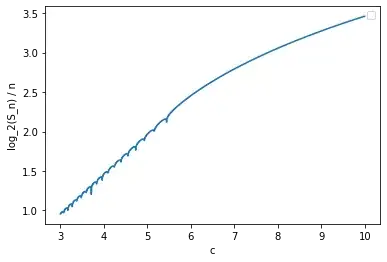My two cents. We can express the inner sum of binomial coefficients $\sum_{j=0}^k{N\choose j}$ with $N=cn+k$ by means of the integral remainder formula for the Taylor expansion of $(1+x)^{N}$
(this one). By linearity the sums over $j$ splits into two sums, the first of whom vanishes:
$$\sum_{k=0}^{n} \left(-\frac{1}{2} \right)^k \binom{n}{k} 2^{cn+k}= 2^{cn}\sum_{k=0}^{n} \left(-1 \right)^k \binom{n}{k}=0,$$
so we are left with
$$
S_n= -cn\sum_{k=0}^{n} \left(-\frac{1}{2} \right)^k \binom{n}{k} {cn+k\choose k}\int_0^1(1+x)^{cn -1}(1-x)^kdx=
$$
$$
= -cn\int_0^1\Bigg[ \sum_{k=0}^{n} \binom{n}{k}{cn+k\choose k} \left(\frac{x-1}{2} \right)^k\Bigg]\big(1+x\big)^{cn -1}dx.
$$
We recognize the sum into brackets as the $n$-th Jacoby polynomial $ P^{\alpha,\beta}_n(x)$, with $\alpha=0$ and $\beta=(c-1)n$:
$$P^{0,(c-1)n}_n(x)=\sum_{k=0}^{n} \binom{n}{k}{cn\choose k} \left(\frac{x-1}{2} \right)^k\left(\frac{x+1}{2} \right)^{n-k}=\sum_{k=0}^{n} \binom{n}{k}{cn+k\choose k} \left(\frac{x-1}{2} \right)^k,$$
and your sum can be written
$$S_n=-cn\int_0^1 P^{0,(c-1)n}_n(x)(1+x)^{cn-1}dx.$$
Note: the integral over $[-1,1]$ vanishes, since it is
$$\int_{-1}^1 P^{0,(c-1)n}_n(x)(1+x)^{n-1}(1+x)^{(c-1)n}dx,$$
and $P^{0,(c-1)n}_n(x)$ is orthogonal w.r.to the weight $(1+x)^{(c-1)n}$ to all polynomials of degree less than $n$. So the
integral on $[-1,0]$ gives $-S_n$, whence we may also express
$S_n$ as $-cn/2$ times the $n$th Fourier coefficient of the function $(1+x)^{n-1}\text{sgn}(x)$ w.r.to the said scalar product on $[-1,1]$, namely
$S_n=-\frac{cn}2\Big\langle P^{0,cn-n}_n(x),\;(1+x)^{n-1}\text{sgn}(x)\Big\rangle.$
Here I stop; but since there is a huge knowledge on Jacobi polynomials, one may hope that the existing bounds or a some smart use of formulas may give a quick conclusion.
